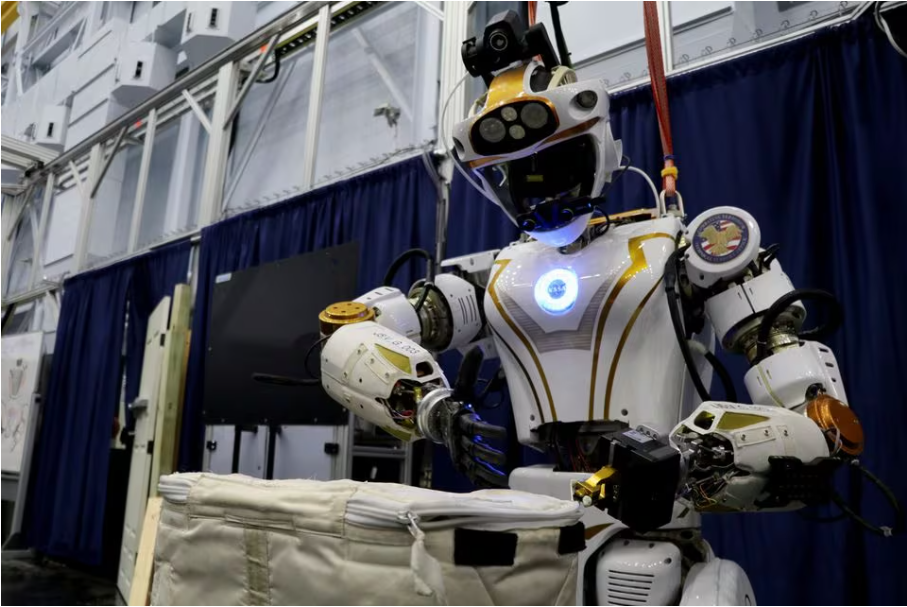
©REUTERS/Evan Garcia
Pre-reading questions:
I will read each question. Then, please answer them.
- What do you know about humanoids and their functions?
- Can you think of any advancements in robotics that have impressed you recently?
Vocabulary:
I will read the words, meanings, and sample sentences. Then, repeat after me.
- assist /uh-SIST/
- optimistic /op-tuh-MIS-tik/
- programming /PROH-gram-ing/
- objective /uhb-JEK-tiv/
- potential /puh-TEN-shuhl/
[verb] – to help
The team worked together to assist the injured hiker.
[adjective] – hoping or believing that good things will happen in the future
The coach is optimistic about the team’s chances in the upcoming match.
[noun] – the activity or job of writing computer programs
Programming demands precision and creativity.
[noun] – something that you plan to do or achieve
The company’s primary objective is to diversify its product line, expand into new markets, and establish itself as a global leader in the industry.
[noun] – the capacity or possibility for growth, development, or success in a particular area
The new technology has great potential for revolutionizing the healthcare industry.
Article reading:
Please read the whole article. Then, I will check your pronunciation and intonation.
NASA in Houston, Texas, is presently testing Valkyrie, a massive humanoid robot towering at a height of 6 feet 2 inches and weighing a whopping 300 pounds. This robot is designed to assist in damaged areas following disasters and could potentially aid in future space missions. Resembling a person, Valkyrie has a head, torso, two arms, and two legs. Engineers are optimistic that, with proper programming, these robots can perform tasks akin to those of humans using similar tools.
Shaun Azimi, the leader of NASA’s Dexterous Robotics Team, mentioned that these robots could handle hazardous duties in space, such as cleaning solar panels or repairing malfunctioning equipment outside spacecraft. This would allow astronauts to focus on exploration rather than perilous tasks. Azimi clarified that the objective is not to replace humans but to handle monotonous, dirty, or hazardous jobs. Collaborating with companies like Apptronik, based in Austin, Texas, NASA is learning from robots designed for Earth. Apptronik is crafting Apollo, a robot intended for tasks in warehouses and factories, facilitating the movement of items. By early 2025, Apptronik aims to deploy these robots, emphasizing Apollo’s extended operation and rapid battery exchange for consistent efficiency. CEO Jeff Cardenas sees potential for Apollo’s expansion beyond warehouses, possibly into retail or other spaces. NASA foresees adaptable robots like Apollo contributing to space missions after improvements and thorough testing.
Shaun Azimi, the leader of NASA’s Dexterous Robotics Team, mentioned that these robots could handle hazardous duties in space, such as cleaning solar panels or repairing malfunctioning equipment outside spacecraft. This would allow astronauts to focus on exploration rather than perilous tasks. Azimi clarified that the objective is not to replace humans but to handle monotonous, dirty, or hazardous jobs. Collaborating with companies like Apptronik, based in Austin, Texas, NASA is learning from robots designed for Earth. Apptronik is crafting Apollo, a robot intended for tasks in warehouses and factories, facilitating the movement of items. By early 2025, Apptronik aims to deploy these robots, emphasizing Apollo’s extended operation and rapid battery exchange for consistent efficiency. CEO Jeff Cardenas sees potential for Apollo’s expansion beyond warehouses, possibly into retail or other spaces. NASA foresees adaptable robots like Apollo contributing to space missions after improvements and thorough testing.
Comprehension questions
I will read each question. Then, please answer them based on the article.
- What is NASA testing in Houston, Texas, and what is the purpose of this robot?
- Describe Valkyrie, the humanoid robot developed by NASA.
- How are engineers envisioning the use of Valkyrie, especially in space missions?
- According to Shaun Azimi, what hazardous tasks could robots like Valkyrie handle in space, and what advantage does this provide for astronauts?
- What is the primary goal of implementing robots like Valkyrie in space missions, according to Azimi?
Discussion questions
I will read each question. Then, please answer them.
- Have you ever seen or interacted with a humanoid robot like Valkyrie or Apollo in your area or during your travels? If yes, what was your impression or experience with it? If not, how do you think you would feel or react when encountering such advanced robots?
- Can you imagine how robots like Valkyrie or Apollo could help in your daily life or work? How would having these robots affect how you do things?
- Do you think it’s a good idea to use robots like Valkyrie and Apollo for dangerous or repetitive tasks so people can concentrate on more creative work?
- How do you think humanoid robots like Valkyrie and Apollo will affect job roles in different industries over the next ten years? What are the good and bad things about this?
- With robots like Apollo advancing quickly, what problems might happen if they’re used a lot in different jobs and public places? Are there any ethical worries or changes in society that could come up because of this?